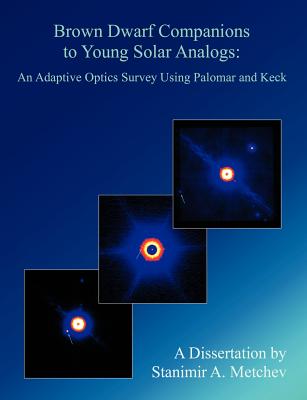You are here
Back to topBrown Dwarf Companions to Young Solar Analogs: An Adaptive Optics Survey Using Palomar and Keck (Paperback)
$25.95
Usually Ships in 1-5 Days
Description
We present results from an adaptive optics survey conducted with the Palomar and Keck telescopes over 3 years, which measured the frequency of stellar and sub-stellar companions to Sun-like stars. The survey sample contains 266 stars in the 3-10000 million year age range at heliocentric distances between 8 and 200 parsecs and with spectral types between F5-K5. A sub-sample of 101 stars, between 3-500 million years old, were observed in deep exposures with a coronagraph to search for faint sub-stellar companions. A total of 288 candidate companions were discovered around the sample stars, which were re-imaged at subsequent epochs to determine physical association with the candidate host stars by checking for common proper motion. Benefitting from a highly accurate astrometric calibration of the observations, we were able to successfully apply the common proper motion test in the majority of the cases, including stars with proper motions as small as 20 milli-arcseconds/year. The results from the survey include the discovery of three new brown dwarf companions (HD 49197B, HD 203030B, and ScoPMS 214B), 43 new stellar binaries, and a triple system. The physical association of an additional, a priori-suspected, candidate sub-stellar companion to the star HII 1348 is astrometrically confirmed. The newly-discovered and confirmed young brown dwarf companions span a range of spectral types between M5 and T0.5, and will be of prime significance for constraining evolutionary models of young brown dwarfs and extra-solar planets. Based on the 3 new detections of sub-stellar companions in the 101 star sub-sample and following a careful estimate of the survey incompleteness, a Bayesian statistical analysis shows that the frequency of 0.012-0.072 solar-mass brown dwarfs in 30-1600 AU orbits around young solar analogs is 6.8% (-4.9%, +8.3%; 2-sigma limits). While this is a factor of 3 lower than the frequency of stellar companions to G-dwarfs in the same orbital range, it is significantly higher than the frequency of brown dwarfs in 0-3 AU orbits discovered through precision radial velocity surveys. It is also fully consistent with the observed frequency of 0-3 AU extra-solar planets. Thus, the result demonstrates that the radial-velocity "brown dwarf desert" does not extend to wide separations, contrary to previous belief.
